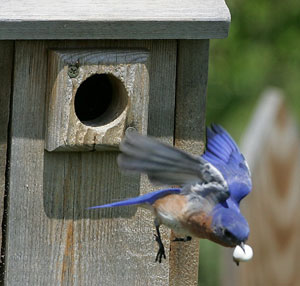Question: I have seen the parents taking something small and white out of the nestbox. What are they doing?

Answer: The parents are removing fecal sacs.
A fecal sac is a clean, tough mucous/gelatinous membrane/film containing the excrement of nestling birds. Cherie Layton calls it a “birdie diaper.” Nestlings usually excrete one sac after each feeding, especially as they get older. The parent grasps the sac by the middle with their beak. They may take out 60-70 bundles a day! Usually both parents help with this task.For hatchlings and very young nestlings (e.g., up to 4-5 days old), the parents may eat the sacs, as the baby’s digestive tracts are not very efficient and the sacs may still contain nutrition. Otherwise, they drop them outside of the box, usually several meters away. I heard one monitor say he saw a bluebird create a little dumping ground in one location.
- Tree Swallows may drop them in a water body. Layton has a hilarious video of a Tree Swallow sticking its butt out of the entrance hole to offer a fecal sac to the parent.
- Barn swallow nestlings, which grow up in an open cup nest (vs. a cavity) will raise their butts up over the edge of the nest and deposit the excrement outside the nest. This can result in a big pile underneath.
- House finch nests look like a Christmas wreath, decorated with a rim of sacs.)
- Downy Woodpecker young only produce a sac every 3-4 feedings. The adult (usually the male) waits around for it to be expelled, and may gently poke the bird near the cloaca to stimulate ejection. Downies do not remove fecal sacs during each visit.
There are several reasons why the parents remove fecal sacs:
- Sanitation: Imagine how gross the nest would get if the fecal sacs weren’t regularly taken out! The excrement would pile up and create a very unsanitary situation, which could encourage bacteria and parasites.
- Bluebirds generally remove fecal sacs right up to fledging (although older, exercising nestlings may “whitewash” the nestbox walls.)
- If a parent is widowed, they may not have the time or energy to remove fecal sacs, and a nest change might be advisable.
- Some species like Tree Swallows stop removing fecal material after the nestlings reach a certain age, so the leftover nest can be a tarry mess. Violet-green Swallow young defecate in one corner of the box after their parents quit cleaning up after them.
- Safety: If the excrement is more liquid than usual, the babies could get stuck to it and be unable to fledge. Wet, feces covered nestlings would have trouble keeping warm. “Fecal glue or glop” is what some bluebird trail monitors call a mucky build up of excretions in a nest. It may be associated with consumption of earthworms. See photo. I always do a nest change if I see “fecal glue.”
- Avoid attracting predators or pests: the scent of fecal material might attract predators. Detritus can also attract fire ants. It may also create an environment more suitable for bacteria, parasites, etc.
If you see bluebird parents STOP removing fecal sacs while the young are still in the nest, there might be a problem with the babies. If you notice a big pile up in a bluebird nest, one or both of the parents may be missing or dead. Nestlings begin to defecate like adults, without the sac, around the time of normal fledging. (BNA)Note that when a nestling is handled by humans (e.g., a wildlife rehabber), they may void a fecal sac. (Handling of nestlings without a permit is prohibited under the Migratory Bird Treaty Act.)
More Information:
- Fecal sacs
- Fecal glue
- How to do a nest change
- Predator & Problem ID and Solution
- Cleaning a nestbox
- Monitoring
- Differences between cavity nesters
- Widows, Widowers, and Orphans
- A couple of video clips of bluebirds feeding and removing fecal sacs from a Bo Villa (PUMA) nestbox
- Controllling ants in a nestbox
- Guinan, Judith A., Patricia A. Gowaty and Elsie K. Eltzroth. 2008. Western Bluebird (Sialia mexicana), The Birds of North America Online (A. Poole, Ed.). Ithaca: Cornell Lab of Ornithology; Retrieved from the Birds of North America Online: doi:10.2173/bna.510
Mouths are open. Eyes are closed. Hints of fuzz where featherswill grow are visible. How do such ungainly, scrawny little creaturesever acquire such phenomenal beauty?
– Shirl Brunnel, I Hear Bluebirds, 1984
